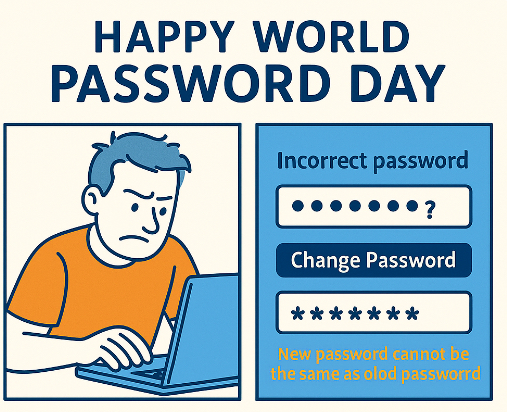
A treatise on memory, failure, identity, and the invisible architecture of access
On its surface, World Password Day might seem like a trivial artifact of the digital calendar—a manufactured reminder, nestled between International Star Wars Day and National Pet Week, urging us to update, complicate, and secure the increasingly chaotic string of logins that control our lives. But like many things about the internet, what appears superficial often hides a deeper cultural truth.
Beneath the polite advisories to refresh your logins and rotate your keystrokes, Password Day is a mirror. It reflects our deepest neuroses about memory, trust, identity, and the failure embedded in the modern digital condition. It is a reminder that we are both the architects and the prisoners of our own access systems—systems that, more often than not, defeat us.
IF AT FIRST YOU DON’T SUCCEED, TYPE AGAIN
The joke goes: If at first you don’t succeed, try again, and then try one more time with a question mark until you’re locked out. Then, wait 10 minutes and try again, all lowercase this time, until you finally give up and request an email to reset it.
Humorous, yes. But it’s also the most accurate account of digital persistence in the 21st century. Every password prompt is a miniature trial—an interrogation of your memory’s fidelity, your past self’s decisions, and your ability to guess what kind of person you once were.
Did you capitalize the pet’s name?
Did you use the number 3 for an E?
Did you include that exclamation point because the system made you, or because you felt defiant?
Password input has become a kind of confessional—intimate, private, and often humiliating. You are not just trying to access your email or bank or cloud archive. You are being forced to reconstruct the logic of a version of yourself that is slightly out of reach. It’s Proustian in its frustration. A forgotten password is a memory misfiled, a love letter lost in your own handwriting.
THE MYTH OF SECURITY AND THE RITUAL OF RESETTING
There is, of course, a serious infrastructure beneath all this. Passwords are not simply gatekeepers—they are cultural signifiers of digital identity. And World Password Day exists because that identity is constantly under siege.
In an age of biometric scans and two-factor authentication, the traditional password—humble, text-based, linear—is showing signs of fatigue. It was never designed for this much responsibility. It was meant to secure a workstation, not an entire life.
Yet we ask it to do more: to be both key and vault. To keep our families safe, our finances intact, our secrets buried. We lace our passwords with our traumas and our dreams. We encrypt love and shame into strings of eight or more characters. We memorialize dead pets and breakup anniversaries.
And when it all breaks down—as it inevitably does—we don’t just request a reset link. We perform a ritual of forgetting. We admit failure. We start again.
THE FOLKLORE OF PASSWORD CREATION
Everyone has a method. Some swear by obscure film references. Others create elaborate acronyms based on childhood memories. A surprising number use old phone numbers, birthdays, or street addresses from homes they haven’t lived in for decades.
There’s a strange intimacy to this process. Password creation is a private folklore, a coding of personal myth. What you choose to protect yourself with often says more about you than the data you’re trying to guard.
Take, for example, the person who uses a grandmother’s name, combined with the year she died. Or the one who uses lyrics from a breakup song, spaced with dollar signs and underscores. This is more than functional—it’s a kind of password poetry. It’s an attempt to inscribe meaning onto access.
FAILURE AS A USER INTERFACE
Most modern login screens now assume you’ll fail. They bake failure into their design: “Forgot Password?” is not a last resort—it’s an expected path. Captchas ask you to prove you’re not a robot, even though the test often feels like one designed by a sadistic AI. Select all the motorcycles. Identify all the traffic lights. Try again.
These are not benign tasks. They are modern riddles, existential traps wrapped in interface language. And the more we fail them, the more we begin to doubt our own humanity. We feel robotic for failing to prove we’re not robots.
There’s something chilling about being locked out of your own life by a system that requires you to remember a detail you created under duress, three laptops and five phone upgrades ago. Something poetic about being denied access by your own imagination.
THE ART OF THE RESET EMAIL
Reset emails have become a genre of literature unto themselves.
They arrive with subject lines that carry quiet urgency:
- Reset your password
- Trouble signing in?
- Someone just tried to log in from an unfamiliar device
They always include a link. A window of time. A tone of caution. And somehow, no matter the service or company, the email always ends with: If you didn’t make this request, you can ignore this message.
It is a strange kind of digital ghost story—evidence of either your own forgetfulness or someone else’s trespass. Sometimes it’s both.
In the reset email, we see a collapse of time. The self of now must reckon with the self of before—and the system that arbitrates between them. In those moments, we glimpse a larger truth about digital life: that access is never entirely ours. It is always mediated. It is always conditional.
THE FANTASY OF BIOMETRICS
To escape all this, we’ve turned toward biometrics. Our bodies—fingerprints, irises, voiceprints, facial structures—have become the new passwords. We are told this is more secure. More natural.
But there’s a horror in that, too. What happens when your face is the password and the system no longer recognizes you? When your fingerprint changes due to accident or age? When the mirror you show the scanner does not reflect who you once were?
In making our bodies the passwords, we tether access to mortality. To change. We make the lock biological. And thus, every login becomes a silent acknowledgment of the body’s erosion.
WORLD PASSWORD DAY: A TIME TO REMEMBER, A TIME TO FORGET
So what does it mean to celebrate World Password Day? To offer digital salutations to the invisible codes that grant us access to everything—from photo albums to financial accounts?
It means reckoning with our failures. Our strange rituals. Our illusions of safety.
It means laughing at the absurdity of trying “Password123!” for the third time and expecting different results.
It means honoring the weird poetry of human memory—flawed, symbolic, romantic.
But more than that, it means remembering that every password is a story: of who you were, who you are, and who you’re trying to become. Sometimes, the story ends in a lockout. Sometimes, it begins again with a reset link. Sometimes, the question mark you added out of desperation becomes the most honest part of the password.
THE PASSWORD AS PHILOSOPHY
Philosophers once spoke of keys to the universe, of hidden names that hold the world in place. In our time, that metaphor has been literalized into login fields. The modern soul is not etched in stone or stitched in scripture—it is encrypted behind eight to sixteen characters, and maybe a special symbol.
We live behind gates we built ourselves. We forget the combinations. We try again.
And in that process—repetitive, frustrating, strangely sacred—we come to understand something essential:
To be human is to forget.
To be digital is to fail gracefully.
To be both is to keep trying, even after the lockout.
Happy World Password Day. May your logins be remembered. And may your resets come swiftly.
No comments yet.








